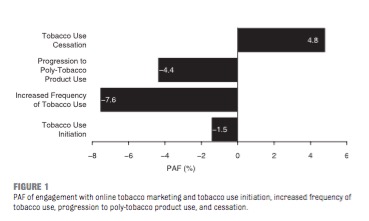Advertising cigarettes and other tobacco products on TV and radio hasn’t been allowed since 1971. The law that proscribed such ads was passed well before the advent of the Internet, however, and on that outlet tobacco companies face virtually no regulation. This avenue of contact concerns many, since adolescents and young adults are major users of social networks and other online outlets.
It's well known that most smokers typically begin their habit during their teenage years. In order to get the powers that be to effect some sort of regulation of such contacts, one must have evidence that they do, in fact, affect young people’s uptake and use of tobacco products.
Recently Dr. Samir Soneji from Dartmouth University and co-workers analyzed data from nearly 12,000 adolescents to understand the extent of their online contact with tobacco products and the extent to which it may have affected their behavior. The data came from the nationally representative Population Assessment for Tobacco and Health (PATH) Study, which is a longitudinal study.
Data from 2013-14 were the baseline, and were followed up a year later (2015-16). In all, approximately 12,000 adolescents provided information about their use of tobacco products. Initially, they determined whether the participants engaged with online tobacco marketing. Then, at follow-up, they determined whether there were differences between those who did and didn’t engage with respect to: frequency of initiation of tobacco use; increased frequency of use in the past 30 days; progression from use of only one tobacco product to multiple product uses; and cessation of tobacco product use.
Participants were queried about their use of cigarettes, e-cigarettes, cigars, hookahs, pipes, snus and other smokeless types of tobacco, dissolvable tobacco, bidis, and kretek (clove cigarettes).
Initially, about 78 percent of the respondents had never used tobacco products, 77 percent said they accessed the Internet at least once per day, and 63 percent used a social network at least once per day. There were multiple ways they accessed tobacco company marketing online. Their most frequent contacts included: signing up for email alerts; reading articles or watching videos online;, using a smartphone to scan a QR (Quick Response ) code about tobacco products to enter a sweepstakes or drawing from a tobacco company; and visiting a tobacco company website.
Probably the most important result of this study involved the adolescents who reported never using tobacco products at baseline. Of these participants, about 20 percent who somehow engaged with online tobacco marketing initiated some form of tobacco use within the following year — this was significantly greater than the 12 percent of those who had not interacted with online tobacco marketing.
Further, the former group used tobacco products more frequently, progressed to using more than one product, and had lower rates of tobacco cessation than did those wh o reported not engaging with tobacco marketing.
o reported not engaging with tobacco marketing.
The figure at right depicts an assessment of the extent to which each characteristic would change if adolescent engagement with tobacco marketing were eliminated. For example, the cessation rate might increase by nearly 5 percent, while initiation could decrease by 1.5 percent.
Thus, the authors concluded,
Adolescent engagement with online tobacco marketing represents a public health problem. Although the FDA has had regulatory authority over tobacco product marketing since 2009, important regulatory gaps remain regarding online marketing. Effective regulation to limit adolescents’ engagement with online tobacco marketing would require active cooperation of social networking sites. Ultimately, lower engagement could mitigate the future population burden of tobacco use by reducing the number of adolescents who initiate tobacco use and increasing the number who quit.




